Landmark carbon reduction project powers ahead
From February issue of NZ Manufacturer magazine. www.nzmanufacturer.co.nz
Around 70% of world’s steel is produced from iron ore reduced in blast furnaces. Most of the remaining 30% is produced by minimills, which recycle scrap steel using electric arc furnaces – a proportion set to grow as companies seek to decarbonise their operations.
Work is underway at New Zealand Steel to install an electric arc furnace: a move which will shrink the carbon footprint of its Glenbrook steel mill and place the company at the leading edge of low emissions steelmaking worldwide.
As the company gears up to celebrate 60 years since it was founded, this crucial upgrade will secure steelmaking – and the corresponding jobs it supports – in New Zealand for the long term.
Announced in May 2023, New Zealand Steel’s electric arc furnace (EAF) project will reduce Glenbrook’s carbon footprint by 800,000 tonnes each year and the country’s total annual emissions by 1% from day one.
The carbon reductions – equivalent to taking 300,000 cars off the road permanently – will come from replacing the steel mill’s existing oxygen steelmaking furnace and two of the four coal fuelled kilns.
Chief Executive New Zealand and Pacific Islands Robin Davies described the project as “a pragmatic response that not only sustains our critical domestic steel supply, but also provides a collaborative approach with public and private sector players to be world leaders in lower emissions steel.”
The company is on track to be producing lower carbon steel as soon as 2026, having continued to hit project milestones such as the completion of a feasibility study, beginning to prepare the site for installation and the signing of new project partnerships since the May 2023 announcement.
Already users of technologies such as robotics, automation, wireless sensors to collect real-time data and computer-aided engineering and design, Mr Davies says his teams are excited about the prospect of incorporating the EAF and switching up the way they make steel.
“EAF technology has advanced considerably, and the furnace we are looking at will see us operating at the cutting-edge of steelmaking technology,” Mr Davies says. “Our parent company BlueScope operates EAFs in other parts of the world – this is proven technology and we’re looking forward to upskilling our teams in new ways of making steel.”
The EAF furnace that New Zealand Steel is going to install has been designed by Italy-based engineering and service company Danieli, using the new DigiMelter technology and powered by Danieli’s proprietary Q-One hi-performance power unit. Q-One is a leading technology which allows fully independent control of process variables.
The EAF will also enable New Zealand Steel to play a part in the local circular economy.
The furnace will melt scrap steel using electricity, instead of converting iron sands by using coking coal to remove oxygen. This upgrade will not only halve the company’s coal use but also divert thousands of tonnes of scrap steel from export to NZ Steel for local recycling.
“Steel is infinitely recyclable and this model will make New Zealand as close to self-sufficient as possible using renewable energy to recycle domestic scrap steel, rather than shipping it offshore,”
Mr Davies says that as well as protecting economic and environmental outcomes, the EAF project is fostering a sense of community and shared responsibility to provide business and employment opportunities for future generations.
“We’re looking forward to welcoming others into the expanding partnership responsible for delivering one of the country’s largest carbon emissions reduction projects,” he says.



